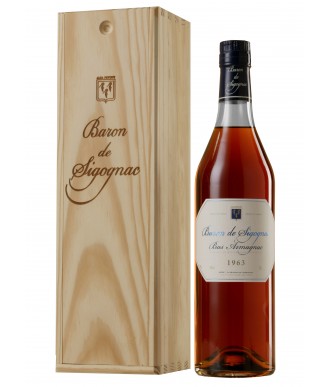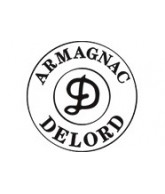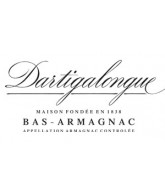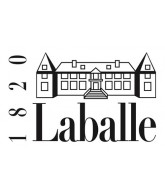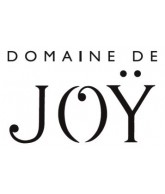Brands
-

With know-how handed down from generation to generation, Armagnac Castarède is distinguished by its heritage and excellence. Florence Castarède, proudly representing the sixth generation, is dedicated to perpetuating the family tradition by producing eaux-de-vie of exceptional quality. Located at Château de Maniban, in Mauléon-d'Armagnac, this estate is the cradle of these fragrant, supple and silky eaux-de-vie, aged beyond the norm to ensure rare finesse.
Founded in 1832, Maison Castarède has a rich history. Encouraged by Baron Hausmann, the company was the first to enter the armagnac trade. A tradition that continues to this day, as several decades later, the family opened a boutique on Boulevard Hausmann in Paris, becoming a benchmark for all armagnac lovers.
The range offered by Armagnac Castarède range is unrivalled in its diversity. Thanks to the age of the company, it offers a range of vintages from 1893 to 2001, including some rare pieces. Each vintage is a celebration of tradition, like the hors d'âge, aged for 20 years in oak barrels. Unique collections, such as the Cigar Collection and the Bruts de Fût, accentuate the distinctive character of this extraordinary range.
-

Discover Armagnac Delord, an elixir born of the expertise of a passionate family line. The story begins with Prosper Delord, an itinerant distiller in 1893, who traveled from farm to farm, transforming white wine into precious Armagnac. His legacy was carried on by his sons, Gaston and Georges, who founded the Maison d'Armagnac Delord Frères in Lannepax, establishing the brand as one of the biggest names in Armagnac, with expansion as far afield as the United States.
The torch has been passed from generation to generation: Jacques and Pierre, then Sylvain and Jérôme, continue to glorifyArmagnac Delord worldwide. In 2020, this latest duo honored the family history by taking over Galaubas, an ancestral Delord estate, and venturing into organic Armagnac production.
Today, Maison Delord covers 55 hectares, passionately cultivating the four traditional Armagnac grape varieties: ugni-blanc, colombard, folle-blanche and baco. In the winery, each grape variety is treated with care, from pressing to vinification, under the expert guidance of Sylvain Delord. The distillery, located in Lannepax, is unique in its kind, practicing both continuous distillation, the signature of Armagnac, and double toasting, thus enriching their range. Ageing, essential for maturation, takes place in their historic cellars, housing over 1,400 casks and majestic oak tuns.
The distillery is located in Lannepax, the family's home village. Distillation, an essential and fascinating stage, usually takes place in the dead of winter. Maison Delord stands out as one of the few Armagnac houses to use both distillation methods. Their two stills, including a historic "Sier" still from 1900, are perfect for the production of old Armagnacs. The aging process in their cellars is rigorous, guaranteeing the preservation of Armagnac eaux de vie dating from the 20th century to the present day. The most precious vintages are carefully preserved in Bonbonne, in a room nicknamed Le Paradis.
Opt forArmagnac Delord, a taste experience steeped in history, tradition and innovation.
-

Armagnacs Baron de Sigognac are renowned for their originality and exceptional quality. Meticulous distillation in small copper column alembics ensures a slow, controlled process, giving each vintage an unrivalled aromatic bouquet. Their vintages, carefully preserved in Paradise, range from 1893 to 2005, promising a unique tasting experience with every sip.
An iconic legend surrounds the name Baron de Sigognac. It is said that one day, this baron, fascinated by the mystery of Armagnac ageing, removed all the traditional clocks from his cellars and replaced them with special dials. On the latter, each dial had only ten divisions, transforming each second into a year and each large hand into a decade. These singular clocks, counting only the centuries, symbolized the Baron's deep connection with time and the unique ageing process of Armagnac.
Legend has it that Baron de Sigognac came to rely solely on his palate to determine the age of his Armagnacs. Abandoning clocks, he became the living embodiment and indelible memory of his precious Armagnacs.
Baron de Sigognac Armagnac is a vibrant and passionate reflection of the soul of Gascony through the centuries. The Guasch family, owners of a vineyard dedicated exclusively to the production of Bas-Armagnac from Ugni Blanc and Baco grapes, invite you to plunge into the heart of this timeless history with Baron de Sigognac.
-
During the reign of Louis XIV, the young orphan Charles, who became a privateer in Saint-Malo, was responsible for the crew's food supplies. To combat scurvy, he introduced an innovative apple juice distillate. Preserved in oak barrels, this beverage is the ancestor of modern Calvados. In recognition of his military exploits, and following an injury, the king awarded him the title of Charles de Granville. Established in Granville, he dedicated his life to improving and producing what would become his signature Calvados Charles de Granville.
-

Bordeneuve Châteaux & Collections illustrates the quintessence of family craftsmanship in the production and maturing of eaux-de-vie of rare finesse, mainly benefiting from the Appellation d'Origine Contrôlée label. Thanks to an estate ideally situated on sandy, tawny soils, and clean, sustainable viticulture, the grape juice obtained is of exceptional quality.
In their distillery, equipped with copper stills, each harvest is the pretext for meticulous distillation, the heritage of know-how handed down from generation to generation. Then, in the old winery dating from 1840, with its thick walls and dirt floor, the maturing of the eaux-de-vie begins. These optimal conditions, combined with the use of new French oak barrels, carefully selected for the quality of their wood and the finesse of their toasting, ensure perfect ageing.
Today, the house is renowned not only for the excellence of its production, but also for its incomparable collection of vintage Armagnacs, patiently aged through the ages. The oldest of these treasures dates back to 1812, a testament to Bordeneuve Châteaux & Collections' unwavering passion and commitment to perfection.
-

Château de Laubade nestled in the heart of Sorbets, in the Gers, is a veritable ode to the richness of Bas Armagnac. Founded in 1870, this 105-hectare estate has been under the aegis of the Lesgourgues family for three generations, with Denis, Jeanne and Arnaud at the helm, continuing the quest for perfection.
This illustrious wine estate, evoking over 150 years of history, was once home to such luminaries as French statesman Joseph Noulens and fashion designer Jeanne Paquin. The Château is an elegant marriage of timeless tradition and modernity.
Today, the Lesgourgues family produces legendary armagnacs, the fruit of artisanal know-how coupled with a spirit of innovation and eco-responsibility. Their technique involves distilling unsulphured white wines immediately after fermentation, in their unique "armagnacais" still built in 1974.
The "simple continuous distillation" process is carried out variety by variety, including Baco, Ugni Blanc, Folle Blanche and Colombard, under the meticulous guidance of the Maître de Chai. The harmony between wine and alcohol vapors is perfectly revealed in the column, aiming for a rich organoleptic palette.
Excellence also lies in patience. Maurice Lesgourgues' vision called for long maturation before bottling to guarantee unrivalled quality. The wine is aged in nearly 3,000 420-liter barrels, with relentless attention to detail, guaranteeing exemplary traceability.
This magnificent château, guardian of Gascon tradition, also places innovation at the heart of its philosophy, with the reintroduction of indigenous grape varieties and the audacity of original affinages. The Lesgourgues family is thus shaping the Armagnac of the future, rooted in respect for the environment and the passion of the men and women who contribute to its production.
Château de Laubade the Lesgourgues family, with its vast vineyards on the hillsides of Bas Armagnac, is a symbol of excellence and heritage, where tradition and innovation meet to create Armagnacs renowned the world over.
-

Château de Millet dèche, a wine icon in the heart of Eauze in the Gers, celebrates five generations of family history, perpetuating the winemaking tradition from father to daughter. Under the leadership of Francis and Lydie Dèche, and now their daughter Laurence, the estate is committed to an exemplary quality approach.
Located in Gascony, in the heart of the prestigious Armagnac region, Château de Millet covers 80 hectares of vines. These lands, once dedicated to mixed farming and Armagnac production, now offer exceptional Côtes de Gascogne "Domaine de Millet" wines.
Perched on the lush hills north-west of Eauze, the vines sink their roots into sandy-clay soils and the emblematic "tawny sands". This unique "Bas-Armagnac" terroir is renowned for its refined, fruity eaux-de-vie.
Acquired by the Dubos family in 1890, the estate's history has been shaped over the decades. From Robert Dèche, who breathed new life into the estate in 1938, to Francis Dèche, who introduced cattle rearing and extended the vineyard in the 1970s, each generation has contributed to its development.
1991 marked a crucial stage with the creation of the EARL du Château de Millet, followed by the introduction of Laurence Dèche in 2002, boosting the marketing of the wines in France and abroad. The estate's philosophy is also oriented towards environmentally-friendly viticultural practices, crowned by HVE 3 certification in 2018.
-

Nestled in the heart of Panjas, in the Gers,Clés des Ducs Armagnac is the embodiment of a centuries-old tradition enriched by the ongoing expertise of its cellar masters. The recent transition from Philippe Lézama to Jérome Zadro marks a new era, while preserving the heritage and methods for which the estate is renowned.
Clés des Ducs Armagnac, mainly made from Ugni Blanc grapes, is renowned for its distinctive character. The distillation process follows tried-and-tested methods, favoring moderate to light barrel toasting to bring out the nuances of the fruit. The practice of limiting ageing in new oak barrels underlines a quest for purity and authentic expression of grape variety and terroir.
Unique terroir and fruit expression
The estate extends over Panjas, Maupas and Estang, benefiting from a tawny sand terroir that imbues the eaux-de-vie with an inimitable signature. This attention to detail is reflected in an approach that excludes any sweetening or coloring, guaranteeing the transparency and integrity of every bottle produced.
Tasting: an invitation to a sensory voyage
Clés des Ducs Armagnac offers a range that celebrates the diversity and richness of aromas, from VS to XO. Each cuvée, benefiting from a specific bonificateur, is a testament to the estate's mastery and passion for revealing taste profiles that privilege fruit and finesse. Spicy, fruity and slightly woody nuances invite sensory exploration, reflecting the estate's commitment to preserving a harmonious balance between tradition and innovation.
-

Since 1838, the DARTIGALONGUE family has been producing handcrafted armagnacs in Nogaro, Bas Armagnac. Continuously owned by the same family, Maison DARTIGALONGUE is proud to have been awarded the Entreprise du Patrimoine Vivant (EPV) label, which recognizes French companies with outstanding craftsmanship and industrial know-how.
The richness of DARTIGALONGUE Armagnac is rooted in the sandy-loam soil of the Bas-Armagnac Terroir, renowned for producing eaux-de-vies of incomparable finesse and elegance. The blend is made from three complementary grape varieties: Ugni Blanc for its fruity notes of pear and apple, Baco 22A for its velvety structure and long finish, and Folle Blanche for its floral elegance.
Distillation takes place in Armagnac-type continuous stills at 58° degrees. This traditional, low-degree method preserves aromas to the maximum, conferring exceptional ageing potential. Gascon coarse-grained oak casks, mainly from the Southwest of France, contribute to the generosity and richness of the eau-de-vie's aromas, with notes of candied fruit in particular. Each year, 30% of the freshly distilled eau-de-vie is placed in new barrels.
The alternation of dry and wet cellars ensures optimal ageing. The dry cellars, situated high up, modulate the ardor of the young eaux-de-vies, while the damp cellars, with their earthen floors, bring roundness and finesse thanks to a more stable temperature.
Ageing is orchestrated by Ghislain Laffargue, cellar master at DARTIGALONGUE since 1990. Benoit Hillion, Director of the House and representative of the 6th generation, is at the heart of all decisions relating to ageing. Together, they shape the blends that define the singular character of the House's armagnacs.
-

Deeply rooted in the winegrowing history of the Armagnac region, the Domaine de Danis is driven by the passion of Victoire and Vincent Piquemal. The 38-hectare estate is renowned for its Côtes de Gascogne white wines. However, it also keeps a specialized corner for grapes destined for Armagnac production.
Victoire has a passion for the Folle Blanche grape variety. So much so that, since 1982, every vintage reflects this devotion. Earlier vintages, on the other hand, are the fruit of an alliance between the Baco and Ugni Blanc grapes. This winemaking know-how, although currently symbolized by the Piquemal family, dates back to previous generations. Indeed, the grandfather also had a green thumb for Armagnac, even if his creations did not bear the "Domaine de Danis" seal. It wasn't until 1986 that parents Victor and Aline Piquemal inaugurated the estate's first official bottlings.
After the harvest, the grapes are pressed and fermented to produce a wine with an alcohol content of around 9% to 10%. Unique in its method, Domaine de Danis does not have its own still. Instead, the tradition calls for a mobile distiller. Each year, this column still, run by Marc Saint Martin, makes the journey to the estate's cellars to perform its magical transformation. This wood-fired distillation produces an Eau de Vie fluctuating between 52% and 54%.
Preservation is just as meticulous. Domaine Danis features two cellars: one wet, the other dry. These environments are ideal for ageing, with some 120 barrels. The first ageing is in new Bartholomo barrels at Le Freche for at least a year. After that, for balanced maturation, the Armagnac is relocated to older barrels, some reaching the venerable age of 45 years.
-

The Domaine de Laballe is a winegrowing gem at the crossroads of the Landes and Gers regions. Its roots lie in an exceptional terroir: the Sables Fauves. These soils, rich in iron oxide, offer unrivalled minerality and freshness, bringing out the very best in the wines and armagnacs produced.
Since Jean Dominique Laudet acquired the estate in 1820, the Laudet family has always looked after it. This love story began when Jean Dominique, after spending more than 20 years in the spice trade in the West Indies, decided to make his dream come true: to produce the oldest eau-de-vie in France, Armagnac. At the time, the estate was a major enterprise covering 600 hectares and employing 120 people.
Over the years, Château Laballe's Armagnacs became increasingly renowned, exporting 200 barrels to New York in 1829. This passion for Armagnac has been passed down from generation to generation, with each descendant adding his or her own innovative touch.
Today, Cyril and Julie Laudet, representatives of the 8th generation, perpetuate this tradition. Every step, from vine cultivation to ageing, aims to fully express the typicity of this singular terroir. Cyril, with Julie's invaluable support, has continued to diversify and innovate. Notably with the production of dry white, sweet, rosé and red wines covering three different appellations.
In addition to Armagnac, the estate's emblem and living testimony to the family's passion, Cyril and Julie have introduced a modern touch with the 3-12-21 range. It offers a renewed vision of Armagnac, suitable for cocktail consumption, symbolizing the rebirth of this mythical eau-de-vie with the slogan:"Armagnac is back!"
For nearly two centuries, Domaine de Laballe has exemplified the perfect fusion of tradition and modernity, producing wines and armagnacs that reflect the soul of a terroir and the unwavering commitment of a family.
-
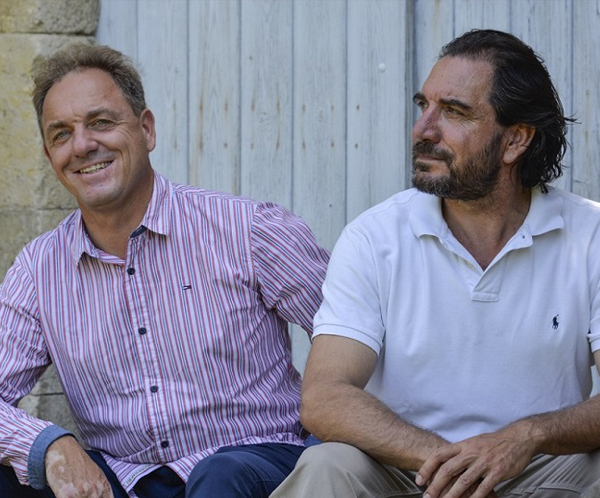
The Domaine de Pellehaut vineyard, perched on majestic hillsides at an altitude of over 180 m, stands out for its exceptional terroir, which enjoys optimum sunshine and natural protection from the Pyrenees mountains. This geographical location ensures moderate summer rainfall, which is essential for the vines.
The name "Pellehaut" has its origins in Roman and medieval pila. Mosaics discovered in Séviac, two kilometers from the estate, bear witness to the millennia-old presence of vines here, dating back to Roman times.
Run today by Martin and Mathieu BERAUT, two passionate brothers, the vineyard is at the heart of a farming operation that preserves the natural balance and traditional methods established by their predecessor, Gaston Béraut. This Gascony-style polyculture combines vineyards, cattle breeding and cereal crops, reflecting a rich family history spanning four centuries.
Over the years, the estate has undergone profound changes. In the 1950s, Gaston Béraut, armed with his knowledge of agronomy, took over the reins of the family estate. The estate subsequently doubled in size to 300 ha, including 50 ha dedicated to vines. This expansion diversified the terroir and ensured abundant water resources for vines and livestock. During this period, Gaston also initiated the distillation of his wines to produce Armagnac.
The winegrowing adventure intensified in the 1980s with the launch of Côtes de Gascogne wines. Since then, the estate has continued to evolve, thanks in particular to the involvement of Martin and Mathieu, whose childhood is intrinsically linked to the rows of vines at Pellehaut.
In the heart of the Armagnac region, Pellehaut is proud of its Ténarèze terroir. Compared to other regions such as Bas Armagnac, Ténarèze offers robust, powerful eaux-de-vie, a reflection of its clay soils. Traditional vinification and distillation, combined with the use of grape varieties such as ugni-blanc and folle blanche, give Pellehaut Armagnac an exceptional smoothness and finesse, recognized worldwide.
-

Domaine de Joÿ, nestled in the heart of Gascony in Panjas, is an iconic family vineyard run by Vanessa, Kévin, and Olivier Gessler. Their commitment to quality has elevated the domaine to a benchmark producer of Côtes de Gascogne wines (including a variety of white wines).
Their unique terrain, covering 170 hectares, benefits from a south-facing exposure which, combined with a clay-silica soil and tawny sands, favors the production of wines with fruity, aromatic notes. The influence of the oceanic climate and the Pyrenees plays a key role in the perfect ripening of the grapes.
The history of Domaine de Joÿ goes back to Paul and Marguerite Gessler, originally from Switzerland, who settled in Joÿ at the turn of the century. Their love of the terroir has been passed down through the generations, gradually transforming the estate into a sanctuary dedicated to white grape varieties. Today, the fourth generation, represented by Vanessa and Kévin, continues to cherish and develop this heritage.
Domaine de Joÿ Bas-Armagnac is the fruit of an ancestral tradition and exceptional know-how. Distilled on the estate using a traditional still, each Armagnac reflects the purity and essence of the Gascony terroir. With meticulous attention paid to every stage of production, the Domaine's Armagnacs are then aged in local oak barrels, giving each drop unrivalled richness, elegance and complexity. This amber elixir is the pride of the Domaine, symbolizing generations of passion and expertise.
Committed to an eco-responsible approach, Domaine de Joÿ adoptedSustainable Agriculture in 2005, culminating in High Environmental Value Level 3 certification in 2019. This recognition salutes their ongoing commitment to biodiversity, ecological management and the preservation of resources.
-

In the heart of the Gers, a new rising star of armagnac is making its appearance: Fitte & Laterrade. The fruit of the collaboration between Vincent Laterrade, a sommelier with a passion for the noble Gascon eau-de-vie, and the Fitte family, skilled winemakers at Château de Herrebouc. Located in the ancestral 15th-century Moulin de Laumet, this unique cellar reveals treasures of vintage armagnacs, timeless testimonies to years of distillation.
Passion and authenticity are the watchwords that drive Vincent. For over two decades, he has been ardently hunting for dormant armagnacs, seeking that perfect harmony between quality and truth. As Christian Millau so aptly put it: " Armagnac can't be bought, it has to be hunted ".
The Fitte & Laterrade credo: pure, unadulterated, vintage armagnacs, straight from the barrel. Each bottle is an ode to Gascony, bottled without prior manipulation, reflecting the very essence of the region. Every element, from bottle to label to wax, is sourced locally, celebrating craftsmanship and exclusivity.
Armagnac and Nature: one can't go without the other. As Vincent points out, each armagnac is the product of a multitude of natural variables, from climate to Gascony oak. Fitte & Laterrade 's mission is not to propose a universal armagnac, but to guide each connoisseur towards the one that speaks to him most, inviting him to create his own "armagnathèque", just as one builds up a precious library.
-
Gaston De Casteljac Cognac is a production dedicated to the ultimate expression of taste quality. Enjoying one of these cognacs is above all an unrivalled privilege. Made from carefully selected, pure, natural white wines, Gaston de Casteljac Cognac evokes the distinctive aromas that bring them closer to the original, traditional cognacs of the 18th century. To retain a rich aromatic range, these wines are distilled slowly and unfiltered, guaranteeing an authentic experience with every tasting.
-

From its deep roots in 1883, the history of Armagnac Jean Cavé radiates passion and expertise. Founded by Jean Cavé a visionary winegrower in Lannepax, this house of excellence has seen four generations master the art of distilling, maturing and ageing eaux-de-vie, while faithfully respecting the spirit and vision of its founder.
Each armagnac from Jean Cavé armagnac is a journey through time, preserved in old oak casks. These carefully selected casks bear witness to the Cavé family's talent and devotion to the Armagnac terroir. Behind each bottle is a story, a unique year and an enduring family tradition.
The vintages, which range from the end of the 20th century to the present day, offer a rare opportunity to savor the singularity of a particular year. Whether it's the vintage armagnacs, reflecting the purity and specificity of a year, or the meticulous blends orchestrated by Maître de Chais, Mathias Rodriguez, each drop captures the richness of the Armagnac region, the dedication and heritage of the Cavé house.
Faced with the evolutions of the modern world, Jean Cavé has not hesitated to venture into the sphere of mixology. In response to the needs of contemporary bartenders and the growing demand for innovation, they have adapted some of their armagnacs. The result? A perfect fusion in which their historic essence blends harmoniously with the flavors of the present, demonstrating the versatility and adaptability of their precious nectars.
From the integrity of the distillation process to the attention paid to every detail, it's this combination of heritage, innovation and authenticity that makes armagnacs Jean Cavé an essential choice for connoisseurs and enthusiasts the world over, seeking to experience excellence with every sip.
-

Since the middle of the 19th century, Distillerie Roger Groult has been firmly rooted in the history and terroir of the Pays d'Auge. Founded in 1860 at the "Clos de la Hurvanière", it embodies the perfect fusion of Norman tradition and constant innovation, offering Calvados of exceptional quality.
Each generation of the Groult family has added its own unique touch. Pierre Groult, by distilling his cider, laid the first stone of this edifice. The recognition of his eaux-de-vie, highlighted by his first Gold Medal in 1893, paved the way for a legacy of mastery and excellence.
Léon's innovations, such as the planting of new orchards and the introduction of additional stills, solidified the distillery's reputation. Despite the trials of time, notably the First World War, the dedication to producing the finest Calvados never wavered.
With the rise of Roger Groult after the Second World War, the distillery underwent a remarkable expansion. His initiative in enlarging the distillery and building a major ageing cellar helped position Groult Calvados on the international stage.
Jean-Pierre Groult, with his forward-looking vision, expanded worldwide distribution while retaining the artisanal essence of Calvados. His efforts to plant new orchards and increase stocks ensured that growing international demand was met without compromising quality.
Today, under the management of Estelle, Charlotte and Jean-Roger, the distillery successfully combines ancestral production methods with modern approaches. Whether it's wood-fired double distillation, perpetual blending or the introduction of original cuvées, each Calvados reflects the rich tapestry of the Groult family's history, terroir and unrivalled expertise.

